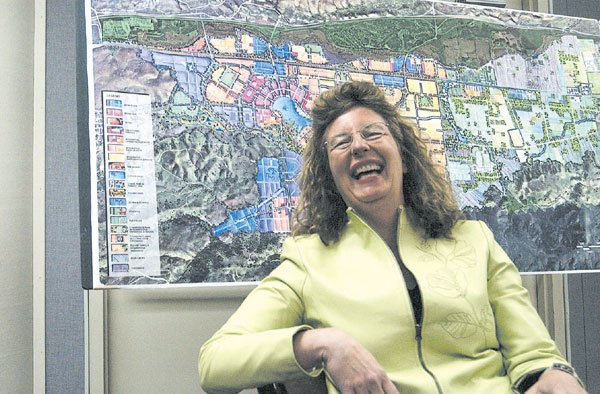San Jose
– Go to almost any public outreach meeting in Santa Clara County
and there’s a decent chance you’ll see Eileen Goodwin. Not only is
she at almost every one, she’s easy to pick out. It’s not just that
she’s pushing six feet before she slips on three-inch heels.
San Jose – Go to almost any public outreach meeting in Santa Clara County and there’s a decent chance you’ll see Eileen Goodwin. Not only is she at almost every one, she’s easy to pick out. It’s not just that she’s pushing six feet before she slips on three-inch heels. It’s also the generous mop of reddish brown curls, the bright clothes and the jewelry.
“Being as tall as I am and because I’m the person people need to find and approach, they need to be able to describe me,” Goodwin said recently.
Goodwin is eccentric in appearance, and if it’s what’s inside that counts, she’s still a bit odd. Goodwin loves meetings. On purpose, she spends more than 40 hours a week in meetings.
“I just genuinely like people,” Goodwin said recently. “A good meeting is one where people show up, there’s debate and there’s discussion.”
Goodwin makes her living consulting for public agencies. As a consultant to the Santa Clara Valley Transportation Authority and the Coyote Valley Specific Plan, Goodwin is in the middle of nearly every development controversy in the county.
“It’s ever-changing and that makes it exciting for me,” she said. “There’s been a lot of twists and turns in how these projects have moved forward. There’s been a lot of moving sideways and then moving forward so we’ve done a lot of circling back to meet the community. My challenge is to always remember where we last left off with the community. I’m like a book mark, I always have to know where the reader is in the story.”
Goodwin specializes in transit and land use. Before she went into business for herself, she ran the Santa Clara County Traffic Authority, the precursor to the VTA that built Highway 85 widened U.S. Route 101 and took the stoplights off Highway 237.
Goodwin was born in Philadelphia and raised outside of Chicago. She was a member of the second class of female students at Claremont McKenna College. She met her husband Kevin when she returned to the Midwest to get a master’s degree in social sciences.
The couple lives in Santa Cruz with their two children. That means Goodwin, who in a typical week will travel from San Jose to Placer County to Seaside and then back to San Jose and then Los Gatos, Marina, San Jose and maybe even Santa Barbara, spends a lot of time in her car, on the order of three to five hours a day. But she’s not about to leave Santa Cruz.
“It’s such a physically beautiful place, regardless of the weather, because of the stunning ocean and hills,” she said.
“I love how artistic and creative [Santa Cruz] is, the people and the scene. There’s a ‘there,’ there. I like the fact that there’s a vibrant downtown.”
Since she founded her company, Apex Strategies, in the mid ’90s, Goodwin has slowly branched out into broader land use issues. She got involved with Coyote Valley in February 2004. San Jose Planner Laurel Prevetti called Goodwin a “terrific pleasure” to work with.
“She’s very sensitive to the political situation and whenever an issue comes up she makes sure we have a game plan,” Prevetti said. “She has tremendous experience.”
What makes Coyote Valley different, Goodwin said, are the resources that San Jose and the developers who are financing the planning process are pumping into the project (Goodwin and the graphic designer she employs have grossed about $100,000 so far).
The Coyote Valley Specific Plan has been hailed as planning at its finest and pelted with abuse. Morgan Hill officials have complained that the development will cause traffic problems and strain the city’s school district (which includes Coyote). Environmentalists have accused planners of subverting the environmental review process and endangering habitat, and property owners in the greenbelt between Coyote and Morgan Hill have complained that they’re being frozen out of a windfall being handed to their neighbors to the north.
Goodwin said that planners haven’t always done a great job of reaching out to the people who oppose the plan.
“Laurel and her team need to be able to articulate their vision,” she said. “Some of the graphics haven’t been helpful as they could be and an issue like the greenbelt hasn’t been addressed as much as it could be. People living in Morgan Hill and Gilroy can’t see the market for dense urban living.”
What planners have done well, she said, is make it possible for the public to air their views.
“We’ve been meeting a lot and there’s usually a couple hundred at each meeting,” Goodwin said. “It’s pretty amazing that they come back over and over again.”
One of the leaders of a group of greenbelt property owners, Richard DeSmet, is a regular attendee. Often critical of the planning process, DeSmet has high praise for Goodwin.
“She does a great job,” DeSmet said. “She’s really good at getting everyone’s opinion out into the open and moving the meetings along. She’s a terrific facilitator.”
Opinions like that may explain why as controversial as the plan is, Coyote Valley is just another day at work for Goodwin.
“I don’t get nearly as many calls for Coyote Valley as for other projects,” she said. “In Fremont, I was part of a 400-acre development project near Dumbarton Bridge that snuggled up to the Coyote Park chain. My phone was ringing off the hook.”















